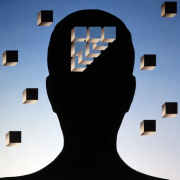Pictures conjured by the mind’s eye lack detail, despite how vividly you picture them
By Simon Makin
Here were the simple instructions given by a Harvard University assistant professor to people participating in a recent cognitive science study:
“Imagine the following scene. Visualize it in your mind’s eye, as vividly as you can: a person walks into a room and knocks a ball off a table.”
The professor, Tomer Ullman, then asked those in the study about nine properties of their mental images, including the color and size of the ball, the shape and size of the table, and the person’s hair color and height. If you are anything like the people in the study, you only visualized a subset of all of these properties. Did you see how big the ball was? How about the person’s hair color? Most participants visualized the former but not the latter.
Ullman and his colleagues term this absence of details “noncommitment” to mental imagery. Psychologists and philosophers have noted the phenomenon before, but a new study published online May 18 in Cognition is the first attempt to gather data on it. The findings show noncommitment is the norm. It has nothing to do with a person forgetting the contents of a mental image, and it also is found in people with vivid imaginations.
The authors frame their findings with an eloquent description at the end of the study: “Mental images fill our daydreams, fuel our fancies, and color our memories. People often experience these images as richly detailed, making the imagination seem like a talented artist quickly painting a lifelike scene before our mind’s eye. Our results suggest that while the imagination may indeed be a good artist, it’s on a deadline, and stingy about paint.”
Beyond providing insight into the nature of the mind’s eye, the research raises a number of questions for further investigation and has implications for gathering eyewitness testimonies. Noncommitment, in fact, plays a role in a dispute known as the “imagery debate” that raged in philosophy and cognitive psychology for decades. One side argues that mental images are like actual pictures that our brain uses directly to reason about things. The opposing camp claims the images are more like sentences describing scenes, and the experience of seeing something in our mind’s eye is smoke and mirrors—it plays no role in cognition.
It’s true that some people lack mental imagery entirely, a phenomenon known as “aphantasia,” but most people say they see things vividly in their mind’s eye, and their bodies even respond as expected to what is imagined. When people visualize dark and light objects, their pupils dilate—unless they happen to have aphantasia. Brain imaging studies also show that mental imagery engages the same neurons in similar ways as perception. Visualizing things seems to have much in common with actually seeing them. But if mental images are indeed pictures, why do they lack such simple details?
Ullman and colleagues conducted a series of experiments in which participants visualized the ball and table scene and were then presented with the nine properties selected by the researchers. They had to respond either “Yes, it was part of my mental image,” or “No, it was not.” Seventy-eight percent of participants did not visualize at least two of the nine details. Ball size and table shape were usually included, whereas the person’s height and hair color often were not. The rest fell somewhere in between. “People are often unaware of how little detail their mental images contain until you ask them about it,” says cognitive scientist John McCoy of the University of Pennsylvania, co-senior author of the study. “You don’t notice how much you don’t notice.”
A second experiment required picturing four other scenes. In the third experiment, participants were given other options to describe each property in addition to yes or no: “don’t know,” “don’t remember” and “other.” Almost nobody chose these, implying that not visualizing a detail is not the same as forgetting or being uncertain about it...
Read the full article on the Scientific American website using the link below.

